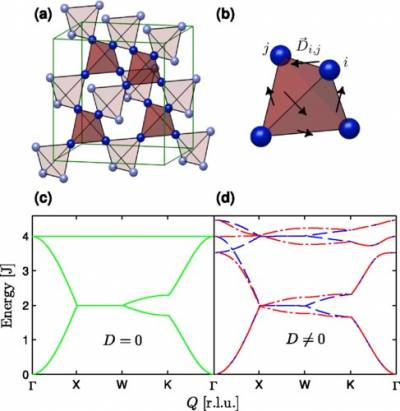The science behind the research
We are interested in a wide range of quantum magnets for variety different perspectives: one interesting example that we have been exploring are the topological effects in quantum ferromagnet Lu2V2O7 [see publications below].
This pyrochlore material has long range ordered, parallel aligned magnetic spins with a non-inversion point group symmetry. This is unusual in that it creates an internal magnetic field via Dzyaloshinskii-Moriya interaction that couples to the magnon spin waves creating a transverse magnetic field gradient or magnon Hall effect.
In the future, this unique effect might be used to manipulate magnetic fields via thermal and electronic currents which would have implications for data reading and storage in magnetic bits.
Ongoing research
Figure 1 shows the pyrochlore structure and calculated spin-wave dispersion for Lu2V2O7 where (a) illustrates the Pyrochlore structure of Lu2V2O7. The V4+ ions (blue) form a network of vertex-sharing tetrahedra with four tetrahedra in the unit cell. (b) is an images of a single tetrahedron where the arrows located between adjacent V4+ sites denote the directions of the DMI vectors; e.g., the vector D⃗ i,j is associated with the interaction between sites i and j.
Calculated spin-wave dispersion for Lu2V2O7 for (c) D=0 and (d) D=J/3 with the local magnetic field H⃗ parallel to either (100) (blue) or (010) (red). Γ, X, W, and K label the high-symmetry points of the conventional fcc Brillouin zone. The data were measured on Merlin at ISIS neutron spallation source, Harwell, Oxon.
| Fig 1. The Pyrochlore structure and calculated spin-wave dispersion for Lu2V2O7 |
 |
Recent Publications
- Spin-Wave Spectrum of the Quantum Ferromagnet on the Pyrochlore Lattice Lu2V2O7. Mena et al. Physical Review Letters 113, 047202 (2014)
 Close
Close

